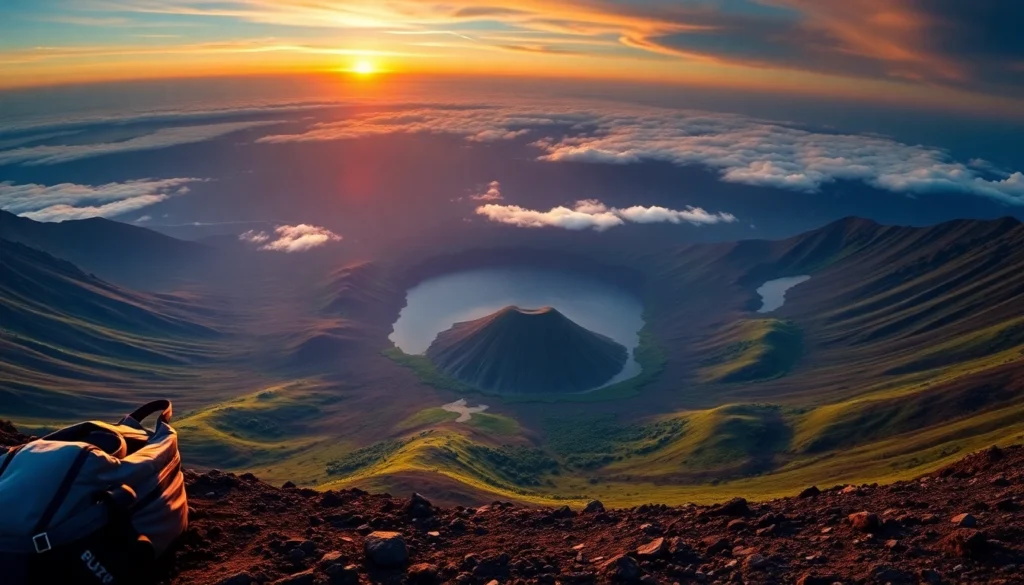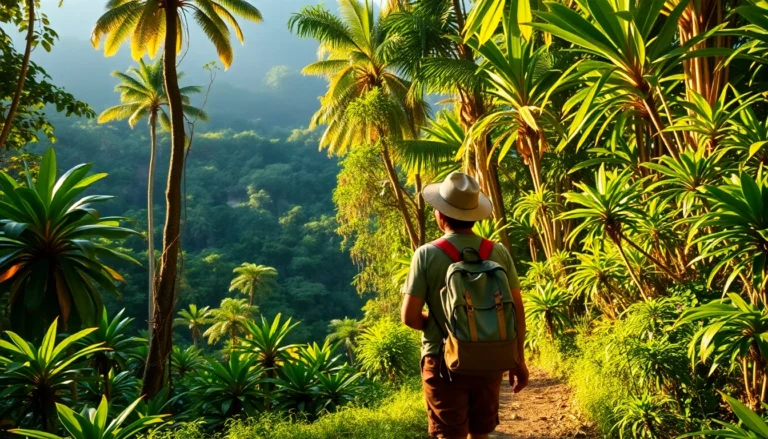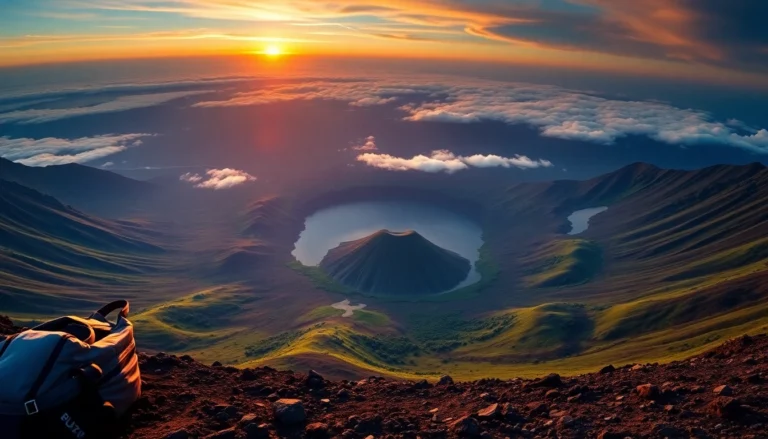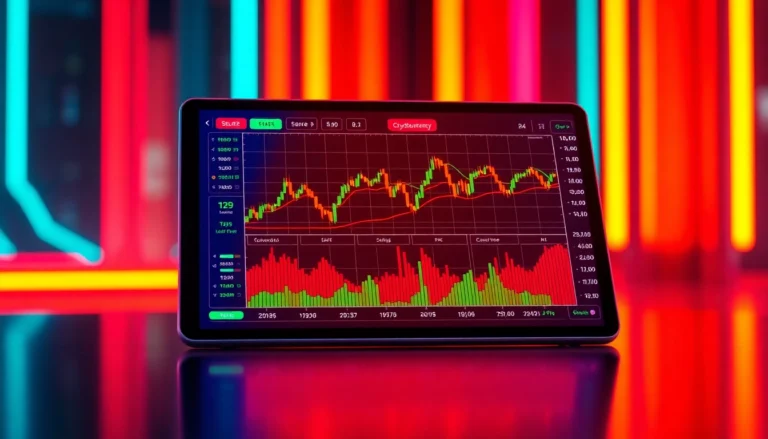
Introduction to Mount Rinjani
Nestled on the Indonesian island of Lombok, Mount Rinjani stands as one of Southeast Asia’s most impressive natural landmarks. As the second-highest volcano in Indonesia, Rinjani offers not only breathtaking scenery but also a profound cultural and geological significance. Its towering presence, measuring approximately 3,726 meters (12,224 feet) above sea level, draws adventurers, nature lovers, and researchers alike from around the globe. This volcano is far more than just a mountain—it’s a gateway to ancient legends, ecological diversity, and unparalleled adventure experiences. Its prominence in Indonesian culture and natural history makes it a must-visit destination for both thrill-seekers and those seeking spiritual connection with nature.
For those contemplating an expedition, understanding Rinjani’s rich history and geological features sets the foundation for a safe and enjoyable journey. Proven by numerous eruptions and a dynamic geological profile, the mountain’s activity has shaped the landscape and local communities for centuries. Its importance extends beyond geology; local legends intricately weave Rinjani into the cultural fabric of Lombok, enhancing its mystical allure. Whether you’re interested in hiking, photography, or ecological conservation, Mount Rinjani’s multifaceted appeal offers a compelling reason to explore this Indonesian jewel.
Top Attractions and Natural Highlights
Rinjani’s Crater Lake and Hot Springs
At the heart of Mount Rinjani lies Segara Anak, a stunning crater lake renowned for its vibrant turquoise waters and unique setting within the volcano’s caldera. This lake, situated at approximately 2000 meters elevation, is considered sacred by local Sasak and Lombok communities. Its mineral-rich waters are a natural marvel, often hosting hot springs that visitors can enjoy after a vigorous trek. The geothermal activity beneath the crater also results in fumaroles and bubbling mud pools, providing a geothermal wonderland that highlights the volcano’s fiery origins. Photographers and nature enthusiasts are drawn to the lake’s mesmerizing reflection of the surrounding peaks and volcanic landscape.
Scenic Trekking Routes and Viewpoints
Rinjani offers a variety of trekking routes, each showcasing different facets of the mountain’s natural beauty. The popular Sembalun and Senaru routes provide contrasting scenic experiences—Sembalun’s lush savannahs and expansive views contrast with Senaru’s dense rainforests and waterfalls. Key viewpoints like Pusuk Pass and the summit itself afford panoramic vistas of Lombok, neighboring islands, and even Bali on clear days. Trekking these routes involves traversing diverse landscapes, from volcanic craters to lush forests, each step revealing the island’s ecological richness. These trails are well-marked and maintained, but choosing the right route depends on your fitness level, experience, and interests.
Flora and Fauna within Rinjani National Park
The Rinjani National Park encompasses an ecologically diverse region, home to over 400 species of plants, numerous bird varieties, and endemic wildlife such as the Rinjani rodent and the endangered Flores hawk-eagle. The park features thick tropical forests, including oak, pine, and various medicinal herbs, which serve as habitats for many species. The floral diversity supports unique ecosystems, with orchids and wild lilies blooming seasonally. Birdwatchers can spot hornbills, kingfishers, and sunbirds flitting through the canopy. The rich biodiversity underscores the importance of sustainable tourism practices to preserve Rinjani’s ecological integrity for future generations.
Adventure Activities and Trekking Tips
Planning a Successful Ascent of Mount Rinjani
Embarking on a Rinjani trek requires meticulous planning and preparation. The standard ascent involves either a 3- to 4-day guided tour, with the summit climb typically performed on the final night to catch the sunrise from the crater rim. Customizing your trip based on fitness levels, weather conditions, and available time is crucial. Early booking of permits and tour packages is recommended, especially during peak seasons. Local tour operators can provide logistical support, experienced guides, and porters, ensuring safety and physical support throughout the hike. Developing a detailed itinerary and understanding the trail difficulty—ranging from moderate to strenuous—are vital for a rewarding experience.
Essential Gear and Safety Precautions
Given the mountain’s challenging terrain and variable weather, packing the right gear is essential. Must-haves include layered clothing (thermal, windproof jackets), sturdy hiking boots, headlamps, gloves, and rain protection. Altitude sickness is a real concern; ascending gradually, staying hydrated, and recognizing symptoms early can prevent serious health issues. Guides and porters are invaluable for logistical and safety support, but personal responsibility remains key. In addition, travelers should carry a basic first aid kit, sufficient food and water, and communication devices for emergency situations. Regular weather updates and trail condition checks must be incorporated into your planning to avoid adverse weather or volcanic activity.
Best Seasons and Recommended Itineraries
The optimal trekking season in Rinjani spans from April to October, corresponding to the dry season when weather conditions are most stable. During this period, visibility is excellent, and trail conditions are optimal for hiking. The peak months of July and August attract the most tourists, so advance booking is essential. A typical 3-day itinerary involves ascending via the Sembalun or Senaru routes, reaching the crater rim, exploring the crater lake, and summiting at dawn. Some trekkers extend their adventure with a 4- or 5-day itinerary, including additional days for acclimatization and exploration of surrounding areas. Proper acclimatization, physical training, and gear preparation are critical components for a successful climb.
Conservation and Responsible Tourism
Efforts to Preserve Rinjani’s Ecosystem
Recognizing the ecological and cultural significance of Mount Rinjani, Indonesia has designated it as a National Park—Taman Nasional Gunung Rinjani—covering roughly 41,330 hectares. Conservation initiatives focus on habitat preservation, anti-poaching enforcement, and eco-restoration projects. Local communities are engaged through conservation programs to ensure sustainable use and to prevent habitat degradation caused by over-tourism and illegal logging. Additionally, ongoing research aims to monitor environmental changes, volcanic activity, and biodiversity health, providing critical data for proactive management.
Guidelines for Eco-Friendly Trekking
Responsible tourism involves minimizing environmental impact and respecting local cultures. Trekkers are urged to follow a “Leave No Trace” ethic: pack out all waste, avoid damaging flora, and stay on designated trails. Using eco-friendly products, supporting local guides and businesses, and respecting cultural sites are also vital. It’s important to educate participants on volcanic hazards and safety protocols. Promotion of community-based tourism ensures the economic benefits of trekking are shared with local residents, fostering sustainable development and cultural preservation.
Supporting Local Communities through Tourism
Tourism is a vital income stream for many Lombok residents. Visitors can contribute by choosing locally operated guides and accommodations, purchasing traditional crafts, and participating in community-led tours. Projects such as homestays and cultural performances offer authentic experiences while providing income directly to local families. Promoting sustainable tourism practices helps balance environmental protection with socio-economic development, ensuring future generations will continue to benefit from Rinjani’s natural and cultural wealth.
Visiting Mount Rinjani: Practical Information
Access Points and Transportation Options
The primary starting points for trekking Mount Rinjani are the villages of Sembalun and Senaru, both located in North Lombok. From Mataram, Lombok’s provincial capital, travelers can reach these villages by car or motorcycle within 2-3 hours. Public transportation options include minibusses and shared taxis, which are affordable and widely available. For international visitors, Lombok International Airport offers domestic and international flights; from there, arranged transfers or car rentals facilitate access to the starting points.
Accommodation and Facilities Near the Park
Accommodations near Mount Rinjani vary from basic guesthouses and homestays in Sembalun and Senaru to more upscale eco-lodges. Many tour operators include accommodation packages as part of their trekking services. Facilities in nearby villages provide essential services—watering points, food stalls, and rest areas—ensuring trekkers can properly prepare before their ascent. Advance booking is recommended, particularly during peak season, to secure a comfortable stay and streamline logistics.
Permits, Entry Procedures, and Safety Advisories
All trekkers must obtain permits through the Rinjani National Park authority, which can be arranged via licensed tour operators or online platforms. Permits include entrance fees and environmental awareness briefings. It is crucial to adhere to park regulations, such as respecting cultural sites, maintaining trails, and not disturbing wildlife. Safety advisories highlight the importance of monitoring volcanic activity—alerts are issued by geological agencies—and following guide instructions at all times. Due to the dynamic nature of volcanic activity, some routes may be temporarily closed for safety reasons.



